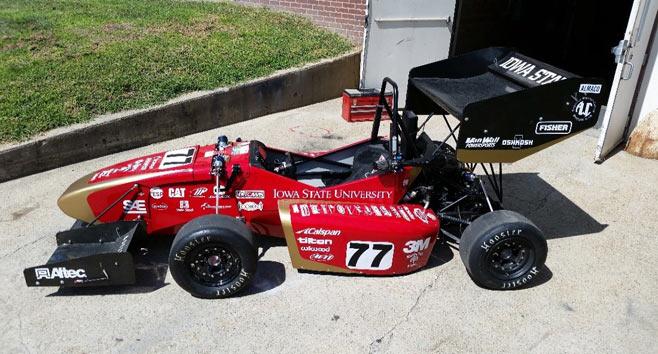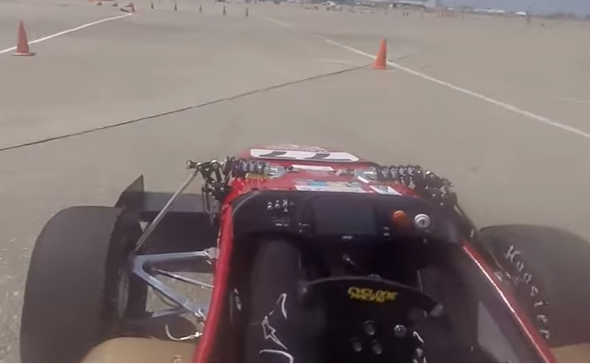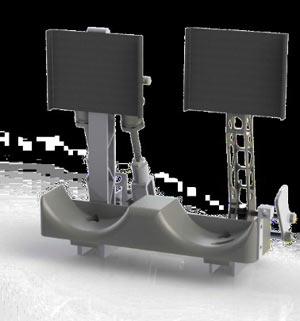 If the technology of 3D printing were given human form I’d venture to say that it might ask us, geez, to ease off with the pressure a little; after all, we are expecting this one process to change the world in so many ways, from saving lives to sending us to Mars and maybe even colonizing the moon. Thankfully this is technology created and manipulated by humans though, and we continue to come through magnificently, whether offering enormous transformation to the medical field, aerospace—or that of the automotive industry—which we are seeing in a different light once again as Stratasys shares recent information on a student project from Iowa State University.
If the technology of 3D printing were given human form I’d venture to say that it might ask us, geez, to ease off with the pressure a little; after all, we are expecting this one process to change the world in so many ways, from saving lives to sending us to Mars and maybe even colonizing the moon. Thankfully this is technology created and manipulated by humans though, and we continue to come through magnificently, whether offering enormous transformation to the medical field, aerospace—or that of the automotive industry—which we are seeing in a different light once again as Stratasys shares recent information on a student project from Iowa State University.
While we are extremely focused here at 3DPrint.com on following the important strides 3D printing is offering throughout the world in truly helping people and progress, we also greatly value its role today in education—and there’s nothing better than seeing that mixed with an enormous amount of fun, as well as adrenaline flow, in the case of a team of students from ISU competing and racing against other college teams in the Society of Automotive Engineers (SAE) International Formula car competition.
Before these excited students could begin building their open-wheel racecar, however, there were a number of questions to consider in the geometry and design such as the level of complexity, how much it should weigh, and what real forces would be at hand acting upon the car on the track. As they began the 3D design process, the team decided to turn to 3D printing for fabrication of the intake, dashboard, and heel cups—all as they set out to create the CR-21, which would hopefully be the best Cyclone ever turned out by ISU.
This is certainly not the first racecar we’ve seen with 3D printed parts, as students at University of Connecticut relied on 3D Systems for help in perfecting a month-long project to create a racecar for their multiple-race SAE competition in Michigan in May and we saw the example of a historical replica made recently by Audi. At ISU, however, the heat was on to outdo themselves, and for assistance in making the 3D printed parts, the students used a Stratasys Fortus 450mc with ULTEM 1010 as their material, due to its superior thermal, chemical, and strength properties.
 The intake creates a crucial way for offering the engine greater horsepower due to superior airflow. In the context of a racecar, the intake’s job—not surprisingly—becomes much more challenging at high speeds. As the students were able to create a 3D printed part for their CR-21 vehicle, they had the latitude to customize the intake with a more conducive geometry, including a gradually sloping inner wall. With this design, the intake would create smoother airflow. Due to the benefits of customization and the ease in digital design, the students were able to make something not available through conventional means. While that’s an incredible perk for makers overall, it is also definitely a major plus in racing, where mere seconds can make the difference between winning and losing.
The intake creates a crucial way for offering the engine greater horsepower due to superior airflow. In the context of a racecar, the intake’s job—not surprisingly—becomes much more challenging at high speeds. As the students were able to create a 3D printed part for their CR-21 vehicle, they had the latitude to customize the intake with a more conducive geometry, including a gradually sloping inner wall. With this design, the intake would create smoother airflow. Due to the benefits of customization and the ease in digital design, the students were able to make something not available through conventional means. While that’s an incredible perk for makers overall, it is also definitely a major plus in racing, where mere seconds can make the difference between winning and losing.
Not only was excellence in design through customization a factor, the students also had a leg up when it came to speed in production. Their new intake was fabricated quite expediently in comparison to the way it was done ‘back in the old days’ without 3D printing. And as we all know, that certainly wasn’t long ago! Without the progressive 3D technology before, an intake was created out of aluminum and had to be machined, milled, and welded. Amidst all of this excitement, challenge and fun, the students too were amassing an extremely valuable new skill set that can be used to solve real world design and engineering problems, bringing the educational aspects full circle.
 As the students considered the amount of stress that might be placed on their 3D printed part, they decided to test it with Finite Element Analysis. This gave them a chance to see what could possibly happen to the intake while the car was on the track, and change things accordingly beforehand. They were able to facilitate edits swiftly and in a streamlined manner in terms of areas of density and thickness that required refinement.
As the students considered the amount of stress that might be placed on their 3D printed part, they decided to test it with Finite Element Analysis. This gave them a chance to see what could possibly happen to the intake while the car was on the track, and change things accordingly beforehand. They were able to facilitate edits swiftly and in a streamlined manner in terms of areas of density and thickness that required refinement.
In making both the heel cups for greater driver comfort and stability and the dashboard (connected to the chassis for supporting the required switches and buttons), the students decided to use ABS 3D printing filament as it allowed for the strength they needed, and was economical for the project.
In the end, the team created a racecar unlike any they had ever built, thanks to 3D printing, and they learned firsthand how it allows for innovation not previously possible, lighter weight components, thinner walls in vehicle construction, less components overall, and better performance due to customized geometries. Check out the video below to see the students’ results, as well as enjoying their awesome soundtrack mashup! Discuss this at the 3D Printed Racecar forum at 3DPB.com.
[Source/Images: Stratasys]Subscribe to Our Email Newsletter
Stay up-to-date on all the latest news from the 3D printing industry and receive information and offers from third party vendors.
Print Services
Upload your 3D Models and get them printed quickly and efficiently.
You May Also Like
TissueLabs Launches Advanced TissuePro Bioprinter for Labs Ready to Scale Up
Swiss biotech company TissueLabs has launched its most advanced bioprinter yet, the TissuePro. Built for tissue engineering and regenerative medicine, the new machine features precise multi-material printing, more automation, and...
3D Printed Microgels from Terasaki Institute Could Help Heal Tissue
In a major step forward for tissue engineering, scientists at the Terasaki Institute for Biomedical Innovation (TIBI) in Los Angeles have developed a light-based 3D printing technique that guides cells...
Auxilium Starts Human Trial for Nerve Implant First Bioprinted in Space
Auxilium Biotechnologies has officially launched a clinical trial for its proprietary NeuroSpan Bridge, a nerve-regeneration implant first bioprinted in space. The implant, created using the company’s AMP-1 bioprinter aboard the...
Parallax Volumetric Additive Manufacturing Debuts at RAPID via Manifest Technologies
Manifest Technologies is showcasing its take on volumetric additive manufacturing at this year’s RAPID+TCT event, this week in Detroit, Michigan. Manifest, formerly known as Vitro3D, spun out of the University...



































